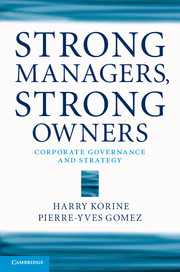Book contents
- Frontmatter
- Contents
- List of Figures
- List of Tables
- Foreword
- Acknowledgments
- Introduction
- Part I Changes in the identity of ownership and management
- 1 Change in ownership
- 2 Change in management
- Concluding remarks
- Part II Changes in the form of ownership and organization
- Part III Changes in strategy
- Part IV Implications for corporate governance
- Notes
- Index
1 - Change in ownership
from Part I - Changes in the identity of ownership and management
Published online by Cambridge University Press: 05 December 2013
- Frontmatter
- Contents
- List of Figures
- List of Tables
- Foreword
- Acknowledgments
- Introduction
- Part I Changes in the identity of ownership and management
- 1 Change in ownership
- 2 Change in management
- Concluding remarks
- Part II Changes in the form of ownership and organization
- Part III Changes in strategy
- Part IV Implications for corporate governance
- Notes
- Index
Summary
The impact of a change in the identity of ownership is of concern to all firms. Every family business has to think about what might happen when the next generation assumes ownership of the firm; every partnership frets over the consequences of bringing in new partners; cooperatives and associations wonder whether the entry of new members will upset the prevailing balance of interests; and, of course, listed companies keep a careful eye on their shareholder rosters to detect changes that might imply a challenge for control.
The purpose of shareholders
In order to understand why changes in the identity of ownership are so important to firms no matter what the form of ownership, we need to start with an explanation of the purpose of shareholders in capitalism. Obviously, shareholders provide capital, but so do banks and trade creditors, and even employees, in the form of human capital. The finance literature emphasizes that the capital provided by shareholders is noncontractual – that shareholders are residual claimants who are only paid if there remains a profit after all other creditors have been satisfied. This defines the type of capital provided by shareholders, but it does not explain their purpose. Why is there a need for residual claimants? The contours of an answer can be found in the distant history of the corporation. As Keynes pointed out in his General Theory of Employment, Interest, and Money (1936: Book 4, Chapter 12), shareholders in the original stock corporations of the seventeenth and eighteenth centuries provided capital that might be irrevocably lost. The collected capital of multiple shareholders is what allowed highly risky ventures such as shipping or trading to be pursued on a large scale. Through their practically irrevocable engagement, shareholders established a general level of confidence in these ventures that would otherwise not have been launched.
Information
- Type
- Chapter
- Information
- Strong Managers, Strong OwnersCorporate Governance and Strategy, pp. 13 - 41Publisher: Cambridge University PressPrint publication year: 2013
